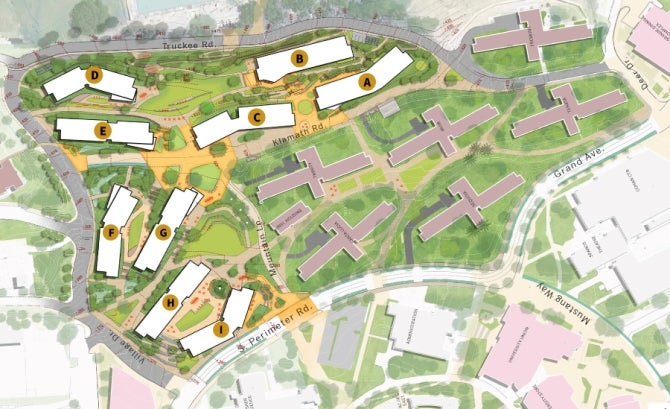Cal Poly Plan to Expand Student Housing Receives CSU Trustees’ Approval

Contact: Matt Lazier
805-756-7109, mlazier@calpoly.edu
Construction is set to begin on the first phase of the 4,100-bed project this summer.
SAN LUIS OBISPO — The CSU Board of Trustees has approved Cal Poly’s plan to launch a 10-year program to expand and improve its campus housing.
At its July 23-24 meeting, the board approved the full program concept and first phase of the Cal Poly Student Housing Project, which will enhance the residential student experience and promote student success. The program will add approximately 4,100 beds to campus housing in nine buildings on the existing site of the K1, K2 and R1 parking lots and the North Mountain residence halls.
The project is part of the university’s larger Future Housing Plan that will help ease existing demand, accommodate future enrollment growth, and address aging campus housing facilities.
The $1 billion Future Housing Plan includes new construction and major renovations to University Housing’s six red brick residence halls, which are more than 60 years old.
“We’re pleased that the CSU Board of Trustees is supportive of this plan,” Cal Poly President Jeffrey D. Armstrong said. “When new construction is complete, University Housing will be able to accommodate all second-year students on campus, connecting them to the community at large, including co-curricular resources and services to better support their retention and academic success.”
Construction starts this month with the first phase — approximately 1,348 beds in three buildings, opening in fall 2026 and fall 2027. Subsequent phases are anticipated to open every year thereafter, with the final phase of new construction completed in 2030.
Residential units will be organized primarily in three-bedroom suites, with each bedroom designed for double occupancy. Each suite will include two bathrooms and a living space to be shared among the suite occupants. The buildings will include a large community space to serve all residents and community commons, study lounges, kitchens, and quiet study spaces throughout.
Each residence hall room and communal space will be fabricated in an offsite factory, brought to campus, and assembled on site. This innovative modular construction strategy allows the university to deliver the project more affordably and efficiently. The project architect is Steinberg Hart. The Design-Build contractor is Whiting-Turner. The project will be designed to achieve LEED Gold certification.
“Supporting student success is at the core of everything we do. Cal Poly already houses all first-year and many second-year students on campus — and being able to house all second-year students on campus gives us an opportunity to check in more often with them to provide that support and connection to services and programs that enhances their academic success,” said Vice President for Student Affairs Keith B. Humphrey. “We’re working closely with students, campus and project partners to design new residential communities that foster learning, engagement and belonging.”
And University Housing’s grant program will continue to support students having the greatest financial need with their housing fees. Since its inception in 2018, the grant fund has grown from $890,000 to $3.6 million — and $1 million dollars is planned to be added to the grant annually to continue to support low-income students living on campus.
Housing will remain open during construction with no loss in bed spaces. For additional information on the project, go to the Future of Cal Poly Housing webpage.
Top image: This summer, Cal Poly embarks on a 10-year Future Housing Plan to enhance the residential student experience and promote student success. The plan will add about 4,100 beds to campus housing in nine multi-story buildings on the existing site of the K1, K2 and R1 parking lots and the North Mountain residence halls. The rendering shows the proposed new construction as well as the existing red brick residence halls (shaded areas) that will be renovated. The first phase of construction, which starts in August, will add about 1,348 beds in three buildings when they open in fall 2026 and fall 2027. Subsequent phases are anticipated to open every year thereafter, with the final phase of new construction completed in 2030.


